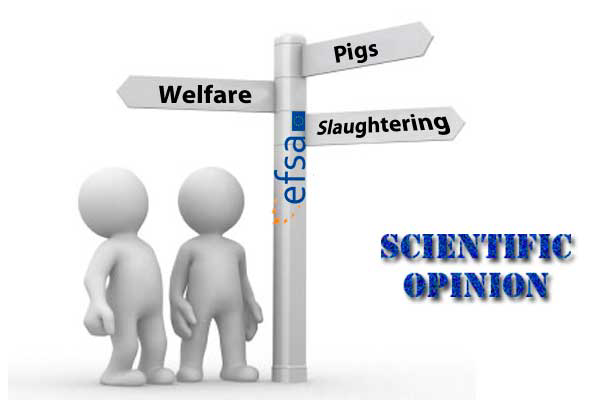EFSA gives opinion on animal welfare at slaughterhouse

Following a request from the European Commission, the Panel on Animal Health and Welfare was asked to deliver scientific opinions on monitoring procedures at slaughterhouses for different animal species and stunning methods.
In particular, the opinions will (i) provide indicators assessing signs of (a) consciousness, in the case of slaughter with stunning, and (b) unconsciousness and (c) death of the animals, in the case of slaughter without stunning, which have been selected based on their performance (i.e. sensitivity, specificity and feasibility of the indicator); (ii) indicate the most common risk factors and their welfare consequences to determine the circumstances of the monitoring procedures; and (iii) provide examples of sampling protocols, based on different possible scenarios.
The current opinion deals with the assessment of consciousness in pigs stunned with the head-only electrical method or carbon dioxide at high concentration. The Working Group agreed that, although it is traditional to look for outcomes of unconsciousness in pigs following stunning, the risk of poor welfare can be detected better if pig welfare monitoring is focused on detecting consciousness, i.e. ineffective stunning or recovery of consciousness. Therefore, the indicators were phrased neutrally (eg. corneal reflex) and the outcomes were phrased either suggesting unconsciousness (eg. absence of corneal reflex) or suggesting consciousness (eg. presence of corneal reflex). This approach is commonly used in animal health studies (eg. testing for the presence of a disease) but very new to animal welfare monitoring in slaughterhouses.
Two different toolboxes of selected indicators are proposed to check for signs of consciousness in pigs after head-only and carbon dioxide stunning. Various activities (two stakeholder consultations, a systematic literature review, an online survey addressed to experts involved with monitoring welfare at slaughter) were carried out in order to obtain information on the sensitivity, specificity and feasibility of the indicators. Based on such information, the most appropriate indicators were selected and a toolbox of indicators to be used in monitoring procedures was proposed. The use of animal-based indicators is similar to the use of a diagnostic or statistical ‘test’ with either a positive or negative outcome. In the case of stunning of the animals, the major interest is to detect the undesired outcome, namely the presence of consciousness in animals. For this reason, the toolboxes propose indicators and their outcomes.
Each of the toolboxes provides a set of recommended indicators and another set of additional indicators. The people responsible for monitoring have to choose the most appropriate set of indicators (at least two indicators) from these toolboxes according to their expertise and the available infrastructure in a slaughterhouse.
Toolboxes for head-only electrical stunning:
After stunning of the animals prior to slaughter the indicators should be repeatedly checked to detect consciousness through the three key stages of monitoring during the slaughter process: after stunning (between the end of stunning and shackling), during sticking (cutting brachiocephalic trunk) and during bleeding.
The recommended indicators in Toolbox 1 (for monitoring after head-only electrical stunning) are tonic/clonic seizures, breathing and the corneal or palpebral reflex. Additionally, spontaneous blinking, posture and vocalisations may be used.
For Toolbox 2 (for monitoring at sticking after head-only electrical stunning), the recommended indicators to be used are breathing, tonic/clonic seizures and muscle tone. Additionally, the corneal or palpebral reflex, spontaneous blinking and vocalisations may be used.
For Toolbox 3 (for monitoring during bleeding after head-only electrical stunning) the recommended indicators are breathing and muscle tone. Additionally, vocalisations, the corneal or palpebral reflex and spontaneous blinking may be used.
Toolboxes for carbon dioxide stunning:
The recommended indicators in Toolbox 4 (for monitoring after stunning with carbon dioxide) are muscle tone, breathing and the corneal or palpebral reflexes. Additionally, response to nose prick or ear pinch and vocalisations may be used.
For Toolbox 5 (for monitoring at sticking after carbon dioxide stunning), the recommended indicators to be used are muscle tone, breathing and vocalisations. Additionally, the corneal or palpebral reflex and response to nose prick or ear pinch may be used.
For Toolbox 6 (for monitoring during bleeding after carbon dioxide stunning), the recommended indicators are muscle tone and breathing. Additionally, the corneal or palpebral reflex and vocalisations may be used.
The personnel performing stunning, shackling, hoisting and/or bleeding will have to check all the animals to rule out the presence of consciousness following head-only electrical or carbon dioxide stunning. The person in charge of monitoring the overall animal welfare at slaughter (i.e. animal welfare officer) has to check a certain sample of slaughtered animals for approval. A mathematical model is proposed which can be used to calculate the sample size that he/she needs to check at a given throughput rate (total number of animals slaughtered in the slaughter plant) and tolerance level (number of potential failures—animals that are conscious after electrical or carbon dioxide stunning). Finally, different risk factors and scenarios are proposed to define, in addition to a ‘normal’ sampling procedure, a ‘reinforced’ protocol to be used if required by the particular circumstances and needs of the slaughterhouse.











